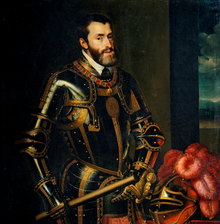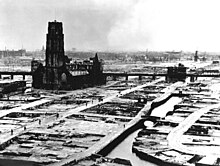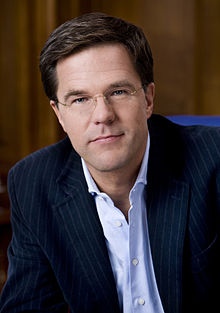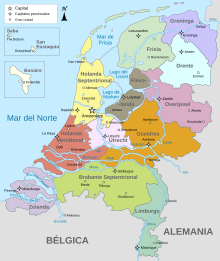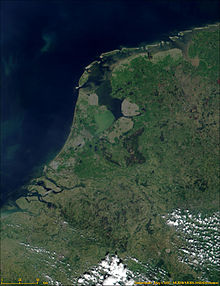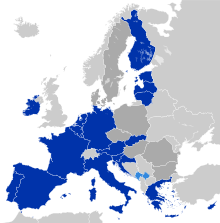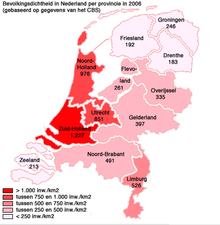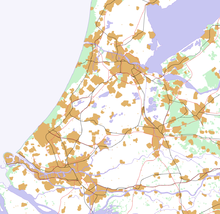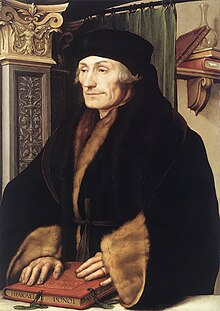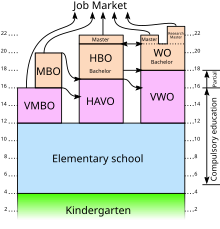Netherlands
Netherlands(PP. BB.in Dutch, Nederland, pronounced/хne felted to reflectl(![]() listen)) is a sovereign country located northwest of continental Europe and the largest constituent country of the four that, together with the islands of Aruba, Curacao and San Martín, form the Kingdom of the Netherlands. The Netherlands is a member of the European Union. Its capital is Amsterdam; however, the organization and administration of the Kingdom is located in The Hague, the official seat of the monarchy, as well as its executive, legislative and judicial authorities. Aruba, Curacao and San Martín are overseas territories that are not part of the European Union.
listen)) is a sovereign country located northwest of continental Europe and the largest constituent country of the four that, together with the islands of Aruba, Curacao and San Martín, form the Kingdom of the Netherlands. The Netherlands is a member of the European Union. Its capital is Amsterdam; however, the organization and administration of the Kingdom is located in The Hague, the official seat of the monarchy, as well as its executive, legislative and judicial authorities. Aruba, Curacao and San Martín are overseas territories that are not part of the European Union.
The country is better known as Holland, after the name of its most influential or relevant historical region, located in the western part of the country. The diccionario panhispánico de dudas, published by the Royal Spanish Academy, admits its use as a synonym. Their language is also traditionally known and for the same reason as Dutch, even though its official name is Dutch; actually Dutch in the strict sense is a dialect of Dutch; admissible by the RAE in common speech, but never in official texts where it must be referred to as Dutch. The same happens with the Dutch demonym. The RAE admits it in common speech, but not for official texts. In that case, the adjective to use is "Dutch".
The provinces that make up the Netherlands are located in northwestern Europe and are bordered to the north and west by the North Sea, to the south by Belgium, and to the east by Germany. The Dutch territory is completed by the special municipalities of Bonaire, Saint Eustatius and Saba, located in the Caribbean. The country is one of the most densely populated areas in the world.
As its name indicates, the country's territory is made up of low-lying land (neder) of which approximately a quarter are located at the level of the sea or below it.
Often, the Netherlands is also confused with the customs union known as the Benelux formed by Belgium, the Netherlands and Luxembourg; the denomination is based on the intergovernmental cooperation agreement that became effective in 1944.
The country is classified as "high income" according to the World Bank and is one of the most developed states: in 2018 it ranked tenth in terms of human development according to the Human Development Index published by the United Nations It is also one of the countries with one of the lowest levels of perception of corruption, and it is one of the most consolidated democracies in the world.
History
Prehistory
The Netherlands has been inhabited since the last ice age; The oldest remains found date back 100,000 years, when the country had a tundra climate with very little vegetation. Its first settlers were hunter-gatherers. At the end of the Ice Age, the area was inhabited by various Paleolithic groups. One of them even made canoes (Pesse, around 6500 BC) and before that, around 8000 BC. C., a Mesolithic tribe resided near Bergumermeer (Friesland).
Agriculture arrived around 5000 B.C. C., through the linear pottery culture (probably from central Europe), but it was only practiced in the plains of the extreme south of the country (South Limburg). The gatherer-hunters of the Swifterbant culture are attested from 5600 BCE. C. and developed an agricultural society around 4300 BC. c.-4000 a. C. in which he highlighted the introduction of small proportions of grains in a traditional economy.
The first notable remains from prehistoric times were dolmens, which have been found in the province of Drenthe, and were probably built by people of the Funnelbeaker farming culture between 4100 and 3200 BC. C. The first evidence of the use of wheels is dated around 2400 BC. C., and is probably related to the Bellbeaker culture (Klokbeker cultuur). This culture also experimented with copper, of which some evidence (stone anvils, copper knives, copper headbands) has been found in the Veluwe park.. The copper finds demonstrate trade with other regions, because copper ore is not found in the country.
The Bronze Age probably began around 2000 BCE. C., as in the tomb of "The blacksmith of Wageningen". After this discovery, more objects from the Bronze Age appeared, such as in Epe, in Drouwen and especially in Drenthe, which, due to The number of objects found, such as tin beads in a necklace, indicate that it was a center of commerce at the time. The wealth of the Netherlands in the Iron Age can be seen in the "Kings Tomb in Oss" (circa 500 BC), a true king was buried there with some items such as an iron sword with a gold and coral engraving in the largest burial mound in Western Europe, which was 52 m wide.
At the time of the arrival of the Romans, the Netherlands was inhabited by various Germanic tribes, who had settled here around 600 B.C. C., such as the Tubanti, the Canninefates or the Frisians. Celtic tribes settled in the south, including the Eburones, Menapios and Texuandri. Various Germans settled in the Rhine delta at the beginning of the Roman occupation, and formed the tribe of the Batavians.
Rome
In the I century a. The Romans conquered the southern part of the country, where they created the Roman province of Germania Inferior. The Romans were the first to build cities in the country, such as Utrecht, Nijmegen, and Maastricht. The northern part, which was outside the Roman Empire and which was the place where the Frisians lived, was heavily influenced by its powerful neighbor to the south.
The relationship with the inhabitants of the country was generally good; many Batavians served in the Roman cavalry. Batavian culture was influenced by Roman culture, resulting, among other things, in Roman-type temples such as the one at Elst, dedicated to local gods. However, this did not stop the rebellion of the Batavians in AD 69. C., led by the Batavian Julio Civilis, an officer of the auxiliary troops. During the revolt, which took advantage of the instability that occurred in the empire during the year of the four emperors, the Batavians managed to annihilate two Roman legions and inflict humiliating defeats on the Roman army. Other Roman soldiers joined the revolt, which even divided the northern part of the Roman army and in April 70 AD. C., Vespasian sent a few legions to stop the revolt. Its commander, Quintus Petilius Cerial, was defeated by the Batavians and entered into negotiations with Julius Civilis, somewhere between the Waal and the Meuse near Noviomagus (Nijmegen) or, as the Batavians probably called it, Batavodurum.
After Rome
The newcomers joined the original inhabitants to create three peoples: the Frisians along the coast, the Saxons in the east, and the Franks in the south. The Franks converted to Christianity after their king Clovis I did so in the year 496, and thus Christianity was introduced to the north thanks to the conquest of Friesland by the Franks. The Netherlands belonged to the Frankish empire of Charlemagne, whose core was in what is now Belgium and northern France, and which also extended through the rest of France, Germany, northern Italy and other territories in Western Europe. In 843, with the Treaty of Verdun, the Empire was divided into three parts: West Francia, East Francia, and Lotharingia. Subsequently, this central empire was divided; most of the Dutch-speaking territories were integrated into Germany, and France tried unsuccessfully to incorporate Flanders.
Between the years 800 and 1000, the Netherlands suffered from the looting of the Vikings, whose attacks were very violent, as in the destruction of the city of Dorestad. But Viking supremacy ended in 920, when King Henry I of Germany liberated Utrecht. German kings and emperors ruled the Netherlands during the X and XI. Germany received the designation of the Holy Roman Empire after the coronation of Otto I the Great as emperor. Nijmegen was a significant place for the German emperors, several of whom were born and died there.
The Crusades were popular in the Netherlands and many joined to go fight in the Holy Land. The Holy Roman Empire proved incapable of maintaining political unity due to the growing independence of the cities. Local rulers transformed their duchies and counties into private kingdoms and felt little obligation to obey the emperor. A large part of what is now the Netherlands was ruled by the Count of the Holland region, the Duke of Gelderland, the Duke of Flemish Brabant, and the Bishop of Utrecht. In the north, Friesland and Groningen maintained their independence and were ruled by the gentry.
Gelderland and the region of Holland were fighting for control of Utrecht. For its part, Utrecht found itself marginalized because of the continuing difficulties it experienced in electing new bishops, while the dynasties of neighboring states were more stable. Groningen, Drenthe, and most of Gelderland, which had been part of Utrecht, became independent. Brabant tried to subdue its neighbors, although their attempts failed. The Netherlands also tried to secure their supremacy in Zeeland and Friesland, but were also unsuccessful. In the north, Friesland retained its independence during this period. It had its own institutions and was opposed to the imposition of the feudal system that could be found in other European locations. Despite this, the Frisians lost their independence when they were defeated in 1498 by the German lansquenet mercenaries of Duke Albert III of Saxe-Meissen.
Burgundy
The Burgundian Netherlands is a term that describes the geopolitical entity that encompassed the territories of the region of the Netherlands (Nederlanden; Lage Landen), which They were incorporated into the domain of the Dukes of Burgundy during the period between 1384 and 1477.
The Burgundian territories were expanded with the County of Namur in 1421, the duchies of Brabant and Limburg in 1439, the counties of Hainaut, the Netherlands and Zeeland in 1432, the Duchy of Luxembourg in 1441 and the Duchy of Gelderland in 1437.
In 1433 much of the territory of the Netherlands and Belgium was unified by Duke Philip III of Burgundy. Germanic Roman Empire. It was during this Burgundian stage that a national consciousness began to emerge among the Dutch. The leading nobles of the Netherlands invited the duke to conquer this country, despite the fact that he had no historical claim on the Netherlands. Amsterdam grew and in the 15th century became the main European trading port for grain from the Baltic region.
Gelders opposed Burgundian rule and tried to create their own state in the north-east of the Netherlands and north-west of Germany. Due to the lack of money, Güeldres made his soldiers provide themselves with what they needed by looting enemy territories. These soldiers posed a great threat to the Burgundian Netherlands. Gelderland was allied with France, England and Denmark, who wanted to end the prosperity of Flanders and Burgundian rule over the Netherlands.
When Charles the Bold, Duke of Burgundy, died in January 1477 at the Battle of Nancy without male issue, King Louis XI of France seized the Duchy of Burgundy and annexed it to the royal domain, on the grounds that the infantazgos had been regulated in such a way that, when the male offspring became extinct, they had to join the Crown. But Mary of Burgundy, the daughter of the Duke of Burgundy, married the future Emperor Maximilian I of Habsburg to defend her inheritance and did not accept the loss of the dukedom, thus maintaining the title of Duke of Burgundy for the prestige granted to its holder by being Grand Master and Sovereign Head of the Order of the Golden Fleece.
In February 1477, Mary of Burgundy granted the so-called Great Privilege to her subjects in Flanders (Belgium, the Netherlands, Luxembourg and northern France), which was signed in Ghent, restoring the privileges taken by the previous dukes, Felipe the Good and Carlos the Bold. It was a Statute that guaranteed the self-government of the Netherlands, according to which a Great Council was created to advise Mary of Burgundy, who promised not to declare war or raise taxes without the consent of the States General of the Netherlands.
When the Treaty of Senlis was signed in 1493, the French retained the territory of the Duchy of Burgundy, but returned Franche-Comté and Artois to the Burgundians. In 1493, Philip the Fair was already of legal age and his titling in 1495 shows his territorial possessions in the Netherlands:
Phelipe par la grace de Dieu Archiduc d'Ausriche, Duc de Bourgoingne, of Lothor, of BrabantStiere, Carinte, Carniole, de Lemberg, de Lucembourg & de GheldresConte de Habsbourgh, of FlandersTyrol, d'Artoisof Bourgoingne Palatin of HoynnauLantgrave d'Elsace, Marquis de Bourgaubb " du Saint Empire; de Hollande, de Zeelandefrom Ferette, from Kiburg, de Namur, & de Zutphen Conte, Seignure de Frese, sur la Marche de Sclanonie, de Portenaub, de Salins, " of Malines.
The marriage of Felipe el Hermoso with the daughter of the Catholic Monarchs and future Queen Juana I made it possible to link the territories of Burgundy and the Netherlands with the future Spanish monarchs.
In the Treaty of Nijmegen (1678), the territory of Burgundy was definitively ceded to France, with which once all the territories of Burgundy (Franche-Comté and Duchy of Burgundy) had been acquired, Louis XIV of France invested his grandson Louis of France (1682-1712), as Duke of Burgundy. On the other hand, Carlos II of Spain and his successors retained the Burgundian titles nominally in their title.
Habsburg Netherlands
By inheritance and conquest the country came into the possession of the Habsburg dynasty under Charles V in the 16th century, who unified them into a single state. The eastern Netherlands was only occupied a few decades before the Dutch struggle for independence. However, in 1548, eight years before he abdicated the throne, Emperor Charles V guaranteed the status of the Seventeen Provinces of the Netherlands as a separate entity from both the Empire and France. This Pragmatic Sanction of 1549 was not of full independence, but allowed significant autonomy.
Emperor Charles was succeeded by his son Philip II of Spain. Unlike his father, who had grown up in Ghent, Belgium, Philip had little personal attachment to the Netherlands, and was thus considered indifferent towards the Netherlands by the local nobility. your state. As a devout Catholic, Philip was appalled by the success of the Protestant Reformation, which led to an increase in the number of Calvinists. His attempts to reinforce the religious persecution of Protestants and his efforts to centralize government, justice, and taxation made him unpopular and led to a revolt. The Dutch fought for their independence from Spain, which led to the Eighty Years' War (1568-1648). Seven rebellious provinces united in the Union of Utrecht in 1579 and formed the Republic of the Seven United Netherlands.
The peace treaties with France (1598) and with England (1604) and the exhaustion from the war led to the establishment of the twelve-year truce.
In practice, the northern territories formed the United Provinces: Holland, Zeeland, Utrecht, Gelderland (with Zutphen), Overijssel (with Drenthe), Friesland and Groniga, as well as the territories of the Generalitat (parts of Brabant, Flanders and Limburg). The southern territories, under the sovereignty of the Habsburgs, formed the Spanish Netherlands: Flanders, Artois, Hainaut, Namur, Luxembourg, Brabant, Antwerp, Mechelen, Limburg. This was reflected in the States General of the Netherlands, since the northern part was established in The Hague and the southern part in Brussels.
In this way, by the Abjuration Act of 1581 and the Twelve Years Truce of 1609, two political entities were formed: to the north, the United Provinces, and to the south, the Spanish Netherlands.
Through the Truce with the northern provinces, the archdukes Alberto and Isabel Clara Eugenia undertook a policy of internal reparation and reorganization, protecting the arts, sciences, as well as commerce and agriculture. In addition, his Perpetual Edict of July 12, 1611 forms the first Belgian legal code. However, although independent, the Netherlands remained within the Spanish sphere of influence.
In 1714, with the Treaty of Rastatt, Emperor Charles VI gained control of the Spanish Netherlands, becoming known as the Austrian Netherlands.
The centralizing policy of Emperor Joseph II of Habsburg against the old privileges provoked a general rebellion in 1788, the Brabanzon Revolution, which declared itself independent and formed the United States of Belgium (January 11, 1790), in a declaration signed by Flemish Brabant, Gelderland, Flanders, West Flanders, Hainaut, Namur, Tournai, Tournaisis and Mechelen, but not Luxembourg.
In the late 1790s, imperial power was restored by Emperor Leopold II of Austria.
During the French Revolutionary Wars, the French Revolutionary Army defeated the Austrian in 1792 at the Battle of Jemappes and conquered the territories of the southern Netherlands, but the Austrian victory at Neerwinden in 1793 sent the French army into retreat.
Finally, in 1794 the French were victorious at the Battle of Fleurus and the Austrians withdrew from the Netherlands again.
On October 1, 1795, the National Convention annexed the Netherlands and the Bishopric of Liège. The loss of territories was recognized by Austria in the Treaty of Campo Formio, October 17, 1797.
Dutch Republic (1581-1795)
William I of Orange, the founder of the Dutch royal family, led the Dutch during the early part of the war. The first years were a success for the Spanish troops. However, subsequent sieges in the Netherlands were broken. The King of Spain lost control of the Netherlands after the mutinous troops of Philip II sacked Antwerp and killed a considerable number of its inhabitants. Conservative Catholics in the south and east supported the Spanish, who recaptured Antwerp and other Flemish and Dutch cities. Although most of the territory in the Netherlands would eventually escape the rule of the Spanish branch of the Habsburgs, the same was not the case in Flanders, resulting in the historical separation between the Netherlands and Flanders). Many Flemings fled to the Netherlands, including half the population of Antwerp, three-quarters of Bruges and Ghent, and the entire population of Nieuwpoort, Dunkirk, and the countryside.
The war continued uninterrupted for sixty more years, but the main confrontation was over. The Peace of Westphalia, signed on January 30, 1648, confirmed the independence of the United Provinces from Spain and Germany. The Dutch no longer considered themselves German since the 15th century, but officially remained part of the Holy Roman Empire until 1648. The national identity was formed mainly by the province from which the majority of the population came. Since the Netherlands was by far the most important province, the Republic of the Seven Provinces came to be known as the Netherlands abroad.
Dutch fishermen hunted whales off the coast of Svalbard, traded spices in India and Indonesia, and founded colonies in New Amsterdam (now New York), South Africa, and the Dutch East Indies. The largest Dutch settlement abroad was the Cape Colony, founded by Jan van Riebeeck on behalf of the Dutch East India Company, in Cape Town in 1652. The Prince of Orange acquired control of the Cape Colony in 1788..
In addition, some former Portuguese colonies were conquered by the Dutch, mainly in northeastern Brazil, Angola, Indonesia and Ceylon. Due to these events, the 17th century is nicknamed the Golden Age of the Netherlands. Since they were a republic, they were ruled more by an aristocracy of urban merchants, called the regents. The Estates General, with representatives from all the provinces, decided those important issues for the entire Republic. However, at the head of each province was the stadtholder of that province, a position held by a descendant of the House of Orange.
In 1650, Stadtholder William II of Orange-Nassau died suddenly of smallpox. His son, the last stadtholder and king of England, William III, was born eight days later, thus leaving the nation without an obvious successor. The princes of Orange became stadtholder and quasi-hereditary rulers in 1672 and 1748. The Dutch Republic of the United Provinces was a true republic only from 1650 to 1672 and from 1702 to 1748. These periods are called the First and Second He was without a stadtholder.
United Kingdom of the Netherlands
The territory of the Netherlands was incorporated into the First French Empire under the reign of Napoleon I from 1810 to 1814. Then the United Kingdom of the Netherlands was formed, which included present-day Belgium and Luxembourg. The Congress of Vienna brought about two important changes: colonial rule over Indonesia was lost, and the north and south of the Netherlands were unified.
The tensions between the north and the south, among other causes due to religious differences, caused the Belgians to declare their independence in 1830 (Belgian Revolution), and although King William I sent troops a year later, the mobilization of the French army in favor of the Belgian cause made him desist from any confrontation. Only eight years later, in 1839, the independence of Belgium was officially recognized.
Queen Wilhelmina's accession to the throne in 1890 meant the separation of the Netherlands from Luxembourg, since the title of Grand Duke could not be inherited by a woman. During the century XIX the country was slow to industrialize compared to Germany or France.
World Wars

Although the Netherlands mobilized its troops in August 1914, they remained neutral during World War I. The German invasion of Belgium that same year induced many Belgian refugees (around one million) to seek shelter in the country. Since the Dutch were surrounded by countries at war and the North Sea was not safe for civilian navigation, food became scarce and rationing became necessary. At the end of the conflict in 1918, the situation returned to normality.
The Great Depression of 1929 had very negative effects on the Dutch economy. As the government of Henrik Colijn refused to change its economic policy and come off the gold standard, the Netherlands took longer to recover from the crisis than other European countries. The depression caused much unemployment and poverty, as well as growing social discontent. The rise of National Socialism in Germany did not go unnoticed in the Netherlands, where fears of a new armed conflict arose. Despite this, the majority opinion among the Dutch was that Germany would respect the neutrality of the Netherlands.
At the outbreak of World War II in 1939, they declared their neutrality once more. However, on May 10, 1940, the Germans launched an attack on the Netherlands and Belgium and conquered most of the country in a short time. The ill-equipped Dutch troops could do very little; on May 14, only a few pockets of resistance remained. However, that day the Luftwaffe (German Air Force) bombed Rotterdam, the country's second largest city, killing 800 people and destroying much of the city, leaving 78,000 people homeless. Following this bombardment and German threats to carry out a similar one in Utrecht, the Netherlands capitulated on May 15 (except the province of Zeeland). The royal family and some troops fled to the United Kingdom. Some members of the royal family lived in Ottawa (Canada) until the Allied liberation.
Japanese forces invaded the Dutch East Indies on January 11, 1942; there the Dutch surrendered on March 8, after the Japanese had landed on Java. However, many Dutch ships and military managed to reach Australia, from where they fought against the Japanese. The winter 1944-1945 was especially harsh, causing famine and going down in Dutch history as Hongerwinter ("Hunger Winter"). On May 6, 1945, Nazi Germany gave in and signed its surrender to the Dutch at Wageningen.
Since 1945
After the war, the Dutch economy prospered and the country became a founding member of the European Coal and Steel Community (ECSC) in 1951, which ultimately led to the founding of the European Economic Community in 1957. Already in 1944 Belgium, the Netherlands and Luxembourg started a customs cooperation under the name of Benelux, (BElgië-NEderland-LUXembourg), which led to an economic union in 1958. The Treaty on European Union or Maastricht Treaty is so known because it was signed in the Dutch city of Maastricht.
In 1953 the country suffered one of the biggest natural catastrophes in its history. On the night of January 31 to February 1, multiple dams broke in the southwest of the country, flooding large areas of the provinces of Zeeland and South Holland, causing the death of about 1,800 people and millions in losses. The Delta Plan began, projecting the construction of large dikes and civil works to retain the ravages of the waters of the North Sea. But the works that were to protect the province of Zealand were not completed until near the end of the 20th century.
The creation of the Benelux, an economic union together with Belgium and Luxembourg, and its subsequent adhesion to other pan-European organizations gave way to the creation of the European Economic Community after the signing of the Treaties of Rome in 1957, for which the countries The Netherlands are considered one of the founding countries of this organization. During the 1970s, the oil crisis caused the different governments to create a front with changes in economic policy, creating an example of growth, what some called polder-economie or polder economy. In 1980, Queen Juliana abdicated in favor of her daughter Beatriz, the sixth monarch since the creation of the Kingdom of the Netherlands and the third woman, after her mother and her grandmother, who reigns the territory consecutively.
The cabinets of Ruud Lubbers (1982-1994) began with a policy of economizing and privatizing. In 1992 the Treaty of the European Union was signed in the city of Maastricht. Wim Kok's cabinet (1994-2002) was made up of liberals and social democrats and was the first cabinet without Christian parties. In 2001, world-first liberal reforms such as same-sex marriage and the legalization of euthanasia were introduced.
On January 28, 2013, Queen Beatrix announced on television her abdication in favor of her son Prince Willem-Alexander, who will reign under the same name on April 30 of that year.
Government and politics
The Netherlands is a constitutional monarchy. The country is described as a state of political-social consolidation, even projecting itself as a status quo of the countries of the world. His government's policies are characterized by an effort to reach broad consensus on important decisions, within the political community and society as a whole. The State is also characterized politically and socially by reforming institutions such as the family and thereby allowing the entry of new ways of social coexistence such as same-sex marriage, transsexuality, euthanasia and the use of recreational drugs.
Within its political conformation, the king exercises executive power and ratifies the free election of the prime minister by the people. The legislative power is represented by what to this day are called States General (Parliament), which consist of two chambers of legislative representation. The judiciary is represented by the Provisional Assemblies, which are also elected by direct suffrage.[citation needed] In the Netherlands, the Dutch state finances, in addition to the salary, all the costs of the Royal House, which includes palaces, air travel, personnel, among others, with costs amounting to 4.5 million euros per year.[citation required]
It is governed according to the 1954 Statute of the Kingdom and the 1815 Constitution, which have been amended on countless occasions. Male suffrage was introduced in 1917 and universal in 1919.
Political-administrative organization
The Netherlands, as the constituent country of the kingdom, is made up of twelve provinces:
- North Brabant
- Dr.
- Flevoland
- Frisian
- Güeldres
- Groningen
- South Holland
- North Holland
- Limburg
- Overijssel
- Utrecht
- Zealand
Each province is governed by a commissioner or governor appointed by the king, and a legislative chamber elected by universal suffrage. The provinces have several municipalities, each governed by a popularly elected junta and a burgomaster or mayor appointed by the monarch.
Likewise, the special municipalities of Bonaire, Saint Eustatius and Saba, located in the so-called Caribbean Netherlands, have been part of the territory of the Netherlands since October 10, 2010, but are not part of any province. Before the dissolution of the Netherlands Antilles, the three municipalities, together with Curaçao and Sint Maarten, were part of the Netherlands, completing the territory of the Kingdom of the Netherlands the constituent country of Aruba, with the same status in the kingdom as the Netherlands since 1986. After that date, Curaçao and Sint Maarten gained the same autonomy as Aruba.
Foreign relations
The foreign policy of the Netherlands is focused on defending the interests of the kingdom and is governed by the desire to promote peace, freedom, well-being and the international legal order. It is largely developed in the decisions of the United Nations (UN), the European Union (EU) and the North Atlantic Treaty Organization (NATO). He was one of the founders of the UN, NATO, the European Community, the IMF (International Monetary Fund), the IBRD (World Bank) and the WEU (Western European Union).
Geography
The name of the country, Nederlanden ("Lowlands"), is due to the fact that a part of the north and west of the country's territory lies below sea level. To the southeast of the country lie the so-called Upper High Countries, which rise a little above sea level.
A complex water drainage system, whose construction began in medieval times, has increased the country's surface area by more than 20%. Without constant drainage, half of the Netherlands would be flooded by the sea and by the many rivers that cross its territory, such as the Rhine that flows into Rotterdam, which has made this city the busiest port in Europe.. Along with the Rhine there are two other rivers that divide the country into two parts, these are the Meuse and the Waal. The highest point in the country is located in Vaalserberg, in the province of Limburg and has an altitude of 321 meters above sea level.
Delta Plan
During the 1953 North Sea flood, a breached dyke killed 1,835 people, forcing the evacuation of another 70,000, and destroyed 4,500 buildings. To prevent such a catastrophe from happening again, an ambitious project was launched, the Delta Plan (Dutch Language: Deltawerken) which linked the mouths of the Rhine and the Meuse.
The most outstanding work in the complex is the Oosterscheldekering, which is considered one of the seven wonders of the modern world according to the American Society of Civil Engineers.
In addition, the Netherlands is one of the countries that suffers the most from climate change. Floods produced by the sea are a problem and an overflow of the rivers could also be very dangerous.
Climate
The primeval biome is temperate hardwood forest. According to WWF, practically the entire country belongs to the ecoregion called Atlantic mixed forest, except for the extreme southeast, which corresponds to the broadleaved forest of Western Europe. The west winds, especially in winter, are strong, the rains copious and the temperatures moderate with hail. The following table shows the climate variations in the country:
| Month | Ene. | Feb. | Mar. | Open up. | May. | Jun. | Jul. | Ago. | Sep. | Oct. | Nov. | Dec. | Annual |
|---|---|---|---|---|---|---|---|---|---|---|---|---|---|
| Temp. max. abs. (°C) | 17.2 | 20.4 | 25.6 | 32.2 | 35.6 | 38.4 | 37.1 | 38.6 | 35.2 | 30.1 | 21.1 | 17.8 | 38.6 |
| Average temperature (°C) | 5.6 | 6.4 | 10.0 | 14.0 | 18.0 | 20.4 | 22.8 | 22.6 | 19.1 | 14.6 | 9.6 | 6.1 | 14.1 |
| Average temperature (°C) | 3.1 | 3.3 | 6.2 | 9.2 | 13.1 | 15.6 | 17.9 | 17.5 | 14.5 | 10.7 | 6.7 | 3.7 | 10.1 |
| Temp. medium (°C) | 0.3 | 0.2 | 2.3 | 4.1 | 7.8 | 10.5 | 12.8 | 12.3 | 9.9 | 6.9 | 3.6 | 1.0 | 6.0 |
| Temp. min. abs. (°C) | -27.4 | -26.8 | -20.7 | -9.4 | -5.4 | -1.2 | 0.7 | 1.3 | -3.7 | -8.5 | -14.4 | -22.3 | -27.4 |
| Total precipitation (mm) | 69.6 | 55.8 | 66.8 | 42.3 | 61.9 | 65.6 | 81.1 | 72.9 | 78.1 | 82.8 | 79.8 | 75.8 | 832.5 |
| Precipitation days (≥ 0.1 mm) | 17 | 14 | 17 | 13 | 14 | 14 | 14 | 14 | 15 | 16 | 18 | 17 | 184 |
| Days of snowfall (≥ 0 cm) | 6 | 6 | 4 | 2 | 0 | 0 | 0 | 0 | 0 | 0 | 2 | 5 | 25 |
| Hours of sun | 62.3 | 85.7 | 121.6 | 173.6 | 207.2 | 193.9 | 206.0 | 187.7 | 138.3 | 112.9 | 63.0 | 49.3 | 1601.5 |
| Relative humidity (%) | 87 | 84 | 81 | 75 | 75 | 76 | 77 | 79 | 84 | 86 | 89 | 89 | 82 |
| [chuckles]required] | |||||||||||||
Economy
The Netherlands has a market economy that is one of the largest[citation needed] and most developed in the world. According to the World Bank, in 2018 its economy grew by 2.6% and reached a GDP per capita of 54,024,059 USD. 70.2% of the labor force works in the service sector, 17.9% work in industry, and only 1.6% of the labor force works in the agriculture sector. In the second quarter of 2019, the rate of Unemployment stood at 3.3%, one of the lowest in the OECD. In 2015, the percentage of the population living on less than $5.50 a day was 0.5%.
The Dutch economy stands out for its high degree of competitiveness, ranking fourth in 2019 out of a total of 141 countries. Trade represents more than 80% of its GDP and if imports and exports are added, despite Although its population has a relative weight of 0.22% in the world population, its trade is equivalent to 4% of the total. In 2006, the port of Rotterdam was the seventh largest container in terms of TEUs. In the north, near Slochteren, is located one of the largest natural gas fields in the world. Up to now the exploitation of this field has given a total income of 159 billion euros since the mid-1970s. With a little more than half of the reserves consumed and expecting a continued rise in oil prices, revenues are expected for decades to come.
Due to the scarcity of natural resources, with the notable exception of natural gas, the Netherlands is highly dependent on imports from other countries.
According to the forecasts of the European Commission, the Dutch economy will grow by 1.7% in 2019 and 1.3% for 2020 and 2021, so it will be a moderate growth, but higher than that of other countries in their surroundings like Germany, Belgium, France.
Tourism
In 2017, some 17.6 million people visited the Netherlands, and the industry employs more than 640,000 people. Amsterdam is the capital of the country and one of the most visited destinations by tourists. The population uses the bicycle as a preferred means of transport. The most relevant places to visit in Amsterdam are the Van Gogh Museum, the Rijksmuseum and the Anne Frank House.
In the rest of the country the most frequent destinations are: The Hague, administrative capital of the Netherlands; Rotterdam with the Europort, the largest port in Europe and second in the world; Gouda, with its cheese market that is held every Thursday; Alkmaar, also important for its cheeses; and Dordrecht, the oldest city in the Netherlands together with Nijmegen and the towns of Lisse and Hillegom, which have the Keukenhof. Delft, Haarlem, Utrecht or Groningen are also important.
It should be noted that the country has seven UNESCO World Heritage Sites. One of them is in the Netherlands Antilles, the historic area of Willemstad. It also has another place, shared with Germany, the Wadden Sea. The rest are: Schokland and its surroundings, the defense line of Amsterdam, the Kinderdijk-Elshout mill network, the Ir.D.F. Woudagemaal, the Droogmakerij de Beemster and the Rietveld Schröder house.
As of 2020, and under the supervision of the Ministry of Foreign Affairs, the brand "Holland" changed, to be known in the same way as the official name of the country "The Netherlands" (NL Netherlands). Netherlands (in English) and in capital letters, NL is the new logo that will replace the toponymic Holland, used until 2019. Embassies and consulates have always used the official name Netherlands, because North and South Holland are only two of the 12 national provinces. The National Tourist Office, which until now is promoted as Holland, will analyze how to adapt the new emblem, effective as of January 1.
Demographics
In the year 2019, it had a population of 17,282,163 inhabitants. The official language is Dutch and the life expectancy is 79.1 years. 99% of the population is literate and they have one of the highest population densities in the world, with 399,494 inhab/km². From 1950 to 2000, the population increased from 10 to 15.9 million inhabitants, but the rate of population growth was slower compared to the previous 50 years. The current growth estimate is 0.412%, with an average number of children per 1.66 woman.
The government encouraged emigration after World War II, fearing overpopulation of the territory. About half a million people left the country, but the number of immigrants, mainly from Indonesia, the Netherlands Antilles, Turkey, Suriname and Morocco, has exceeded the number of emigrants in recent years.
The current ethnic composition is as follows:
- 80% Dutch
- 2.4% German
- 2.4% Indonesian
- 2.2% Turkish
- 2.0 % Surinamese
- 1.9% Moroccan
- 0.8 % Antilles and Rubbins
- 6.0 % other
Urbanization
The country is densely populated, although the cities are modest in size compared to other European or world countries. They are not very large, but their average degree of urbanization is very high. The capital and largest city is Amsterdam, although the government is located in The Hague. While the capital is generally defined as the city where the seat of government resides, in this case no one would ever call The Hague the capital, although it is known as the "legal capital of the world".
Randstad
The Randstad (from the Dutch rand, 'edge', and stad, 'city') is the name given to the largest conurbation in the Netherlands, in turn one of the largest in Europe.
A distinction must be made between the Randstad metropolitan region, with a population of around 6.5 million inhabitants (40% of the total of the Netherlands), and the Randstad Region (a socio-economic association), which brings together some 7.6 million inhabitants (almost half of the country's population). Both entities extend through the provinces of South Holland, North Holland, Utrecht and Flevoland.
Metropolitan areas
Culture
During the Gothic and Renaissance periods, the Netherlands began to experience remarkable artistic development, especially in painting. On an intellectual level, Erasmus of Rotterdam, born in the Netherlands, had a great influence on the cultural life of his country and of Europe during the century. XVI. Subsequently, and in his honor, the Erasmus Prize has been awarded since 1958 in the field of humanities, social sciences and the arts.
In the 17th century, during the period known as the "Dutch Golden Age", the cultural influence of the country had its peak. Among the most notorious Dutch figures of that time were Christiaan Huygens and Baruch Spinoza. In addition, there were foreigners who lived in the country thanks to its atmosphere of tolerance, such as the French René Descartes or the English John Locke. The country is popularly known for its windmills, wooden shoes, tulips, bicycles, and social tolerance.
Painting
Dutch Baroque painting is bourgeois, dominating the themes of landscape, portraits and daily life, with the figure of Rembrandt as its best exponent. In this «Dutch Golden Age» of the 17th century also stood out Johannes Vermeer, Frans Hals and previously Hieronymus Bosch. In more recent centuries, the country has produced notable painters such as Vincent van Gogh or Piet Mondrian.
Mondrian's abstraction was developed from the cubist grid, which he progressively reduced to horizontal and vertical lines that enclose planes of pure color. By simplifying it, the language of neoplasticism (see De Stijl). In the interwar period, Theo van Doesburg, after having been one of the main defenders of Neo-Plasticism, decisively renewed abstract art by maintaining that artistic creation should only be subject to controllable and logical rules.
Literature
In the Middle Ages, the Old Dutch version of a French chivalrous story stands out, Flowers and Blancaflor, inspired by a tale from A Thousand and One Nights; original is, however, Karel ende Elegast (Charlemagne and Elegast); there is also a Dutch version of the French Roman del Renart. The first poet of known name is Hendrik van Veldeke (ca. 1170). The mystic Jan van Ruusbroec (1293-1381) is considered the father of Dutch prose, whose work Die Chierheit der Gheesteliker Brulocht (The Garment of the Spiritual Wedding) influenced ascetic and mystical literature from all over Europe. Renaissance humanism produced figures such as Erasmus of Rotterdam and culminated in the Golden Age of Dutch literature, the 17th, when the Bible was translated into Dutch with different peculiarities of each dialect to forge a common literary Dutch; this is the so-called Bible of states. The most important authors of this golden age were Joost van den Vondel, Pieter Corneliszoon Hooft, Constantijn Huygens and Gerbrand Adriaensz Bredero. In the 18th century stands out a singular couple of women writers who lived together, Betje Wolff (1738-1804) and the friend of she Aagje Deken (1741-1804), who write remarkable epistolary novels. The 19th century romantic generation is represented by Willem Bilderdijk (1756-1831), Hiëronymus van Alphen (1746-1803), Rhijnvis Feith (1753-1824), Hendrik Tollens (1780-1856) and A. C. W. Staring (1767-1840). In the narrative, Multatuli stood out with a novel that denounces colonialism, Max Havelaar (1860), and in the essay Busken Huet (1826-1886). Naturalism is represented by Marcellus Emants (1848-1923). The generation of 1880 took him as a precursor, forming a group called the Tachtigers: Willem Kloos, Hélène Swarth, Albert Verwey, Frederik van Eeden, Lodewijk van Deyssel and Herman Gorter. In the XX century, mention must be made of the psychological novel by Louis Couperus and, after the Second World War, three authors who dominated the panorama: Willem Frederik Hermans, Harry Mulisch and Gerard Reve. Then Hella Haasse and Cees Nooteboom stood out, among many others as important as these.
Gastronomy
Cooking is characterized by the consumption of large quantities of bread and potatoes. A round toast spread with butter is very popular: the beschuit, which is usually eaten for breakfast, with different flavors and used in different celebrations. One of the national dishes, erwtensoep, which is basically a pea soup, is also famous.
Cheese are popular, among which Gouda, Edam and Leyden stand out. Many of the cities in the east have their own cheeses, some of them distinguishable only by taste and outward appearance. But as in all European countries, regional differences are evident and each region has its typical dishes. The Protestant north has a different way of seeing life than the Catholic south; and that is also reflected in its gastronomic influences. Also noteworthy is the herring sandwich (haring broodje). Their most appreciated sweet are syrup-filled cookies called stroopwafels.
Language
- In the country the majority of the population speaks Dutch, which is the official language, but also provincial languages and regional dialects are recognized. It is also spoken in Flanders and Suriname, while in Indonesia the younger generations are beginning to recover the use of the language in the country, up to now mostly in the population who knew Dutch colonization.
- Frisian is the co-official language in the province of Frisia, and is spoken by 453 000 people.
- Several dialects of Dutch bass sajón are spoken in the northeastern part of the country and are recognized by Dutch as regional languages according to the European Charter of Regional or Minority Languages. They're spoken by 1 798 000 people.
- Another Dutch dialect is limburgués, which is spoken in the southeast of the province of Limburg and is spoken by 825 000 people.
- In South Africa and Namibia, the descendants of Dutch settlers speak Afrikaans, a language that descends from Dutch.
It is traditional in the country to speak other languages, 70% of the population have a high knowledge of English, between 55 and 59% speak German and about 19% speak French.
Religion
| Religions in the Netherlands (2015) |
|---|
| Irreligion (non-believer) (Atheo) (Agnosis) 50.1% Catholic Church 23.7% Protestantism 15.5% Other Christians 4.6% Islam 4.9% 1.1% |
After the reform of the 16th century, the country was divided into a Catholic part and a Protestant part. Their separation is roughly from southwest to northeast: the former is Catholic while the latter, Protestant, includes various branches, such as the Reformed Church (Calvinists) and the Lutherans.
In 2005, 43.6% of the Dutch population is Christian (27% declared themselves Catholic Christian, and 16.6% declared themselves Protestant Christian). 5% of the population is Muslim, a small percentage is Jewish, and 48% of the population does not declare themselves to belong to a religion in general. After the attacks in Europe, non-Muslim Dutch citizens viewed Islam as a threat, and the presence of Muslims as something unpleasant, although since 2006 they have been less negative about their presence. This seems to be due to the fact that there have been no serious attacks in that time, the exhaustion on the subject and the increase in contact between non-Muslims and Muslims.
According to the 2005 Eurobarometer survey, 34% of Dutch citizens answered "I believe there is a God," while 37% answered "I believe there is some kind of spirit or life force" and 27% said "I do not believe that there is any kind of spirit, god, life or force". In addition, 41% of the population admitted that they habitually think about the meaning and purpose of the life and 6% said they never thought about it.
Technology
The Netherlands has always stood out for being at the forefront in terms of technology and its application in areas such as urban planning, ecology, medicine, education, etc.
The European Commission has published the results of the 2016 edition of the Digital Economy and Society Index in which Denmark, the Netherlands, Sweden and Finland continue to occupy the top positions of these results.
Education
Education is divided into schools and different age groups within them, some of them with different educational levels. The schools are divided into public schools or special religious schools. The PISA Report, which is coordinated by the Organization for Economic Cooperation and Development, placed the Netherlands in ninth place in world education in 2008, obtaining considerable growth in the average of the Organization.
Elementary education covers from four to twelve years. From the age of five it is compulsory. From the age of twelve, you can choose between completing your middle level preparatory education (consisting of four years), continuing general education (consisting of five years), or preparatory scientific education (consisting of six years). Once these studies are finished, you can choose to do tertiary education, including universities. Upon completion of these studies, a master's degree can be completed with an average age of twenty-two years, and then start working. All universities, with the exception of Nyenrode, receive funding from the state. The universities of Amsterdam, Delft, Leiden and Utrecht are ranked each year among the top hundred in the world.
Sports
 Netherlands at the Olympic Games
Netherlands at the Olympic Games Soccer Selection of the Netherlands
Soccer Selection of the Netherlands Soccer/Football in the Netherlands
Soccer/Football in the Netherlands Basketball selection of the Netherlands
Basketball selection of the Netherlands Eredivisie
Eredivisie
One of the most important sports in the country is cycling, both on the road and on the track. Jan Janssen and Joop Zoetemelk are the only Dutchmen to have won the traditional Tour de France, in addition to triumphing in the Cycling World Championships and the Olympic Games. Other cyclists, such as Leontien Van Moorsel and Marianne Vos have also triumphed in the Olympic Games and has won world championships. Also worthy of mention are Olympic Games and World Championships champions Hennie Kuiper, Jan Raas and Gerrie Knetemann.
Soccer is the other branch of sports that is also very popular. Clubs such as Ajax Amsterdam, Feyenoord Rotterdam and PSV Eindhoven are known. These managed to be the greatest European champions in their history, but only Ajax Amsterdam and Feyenoord Rotterdam (who have a historic rivalry with each other) managed to be crowned world club champions. There are other clubs known locally such as Sparta Rotterdam (one of the oldest in the country), and others such as AZ Alkmaar and Football Club Twente, both league champions on occasion. Apart from these successes, the Netherlands have had several Ballon d'Ors such as Johan Cruyff, winner on three occasions, Ruud Gullit, winner on one occasion or Marco van Basten winner on three other occasions. In addition to these three footballers, the Netherlands The Netherlands also have others known worldwide such as Kees Kist, Wim Kieft (Golden Boot winners along with Van Basten), as well as others like Johan Neeskens, Rob Rensenbrink, Dennis Bergkamp, Ronald Koeman, Edwin van der Sar, Clarence Seedorf, Robin van Persie, Patrick Kluivert, Wesley Sneijder, among others. Many of these players have acted in important European clubs.
The national league is known as the Eredivisie, and is currently one of the top 10 leagues in Europe. The Eredivisie was considered in the 1990s as one of the strongest in the world according to the Federation of Football History and Statistics, being chosen as the third best in 1992.
The only title for the Netherlands national soccer team (which for a time was popularly known as "A Clockwork Orange") is Euro 1988, held in West Germany. She was runner-up in the world in 1974, 1978 and 2010.
Tennis has also had successes, although it is not as relevant as soccer and cycling. Richard Krajicek is the only Dutchman to win a Grand Slam tournament, specifically the Wimbledon Championship, in 1996. Martin Verkerk is another player who has reached a Grand Slam final, in 2003, although he fell to Juan Carlos Ferrero in Roland Garros. Field hockey is also one of the most important sports branches worldwide. The Netherlands women's field hockey team managed to win the field hockey world championship up to six times and the men's team has also done so twice.
He also stands out in swimming with great swimmers and various world records such as Inge de Bruijn, winner of eight Olympic medals between 2000 and 2004, four of them gold, as well as breaking 10 world records, Pieter van den Hoogenband three-time Olympic champion, 14-time European champion and 43-time national champion, Marleen Veldhuis, who held the world record for the 50-meter freestyle as well as the 4 x 100-meter freestyle.
In motorsports, Circuit Assen is considered the cathedral of world motorcycling, hosting the Dutch Motorcycle Grand Prix, while Circuit Zandvoort hosted the equivalent of Formula 1 for many years. In this last category, Max Verstappen is the youngest driver in history to debut in the world championship and also the youngest to win a grand prix, apart from being the only Dutch driver to do so, and, in 2021, he has become the first Dutch pilot to be proclaimed world champion in this category. In 2022 he has become a two-time champion of the highest category of motorsport, even breaking records and reaching 15 victories in one season. In addition to the previous one, only one other Dutch driver, Jos Verstappen (his father), managed to get on the podium.
In other sports such as athletics, Ellen van Langen, winner of the 800-meter dash at the 1992 Barcelona Olympics, stands out, but above all Fanny Blankers-Koen, four times a gold medalist at the 1948 London Olympics. In Anky van Grunsven has won eight Olympic medals in dressage. In baseball they are the first European power thanks to the fact that in the Dutch Caribbean territories of Aruba and Curaçao it is the most popular sport and the vast majority of the players that make up the national team come from or have origins in them. In martial arts they are a country with a long tradition of kickboxing fighters like Peter Aerts, Ernesto Hoost, Remy Bonjasky or Semmy Schilt who have completely dominated international competitions.
Contenido relacionado
179
38
August




